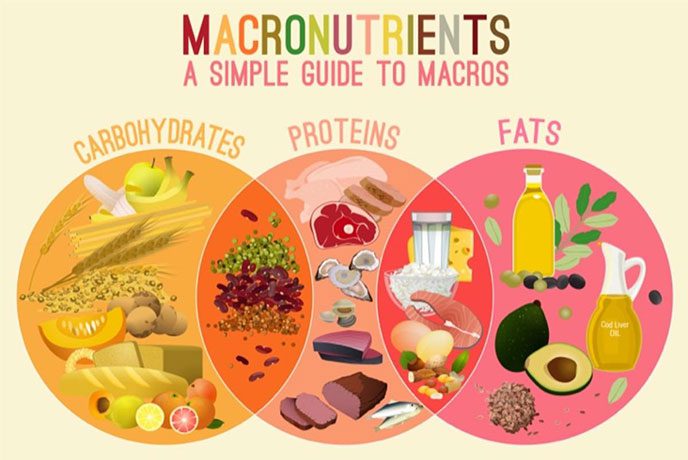What are Macronutrients?
Any item that provides high amounts of calories (energy) is referred to as a macronutrient. Macronutrients are sometimes referred to as “macros” for short. Carbohydrates, proteins, and lipids are all macronutrients. These three nutrients give the body the energy it needs to perform basic activities like breathing, circulating blood, and moving muscles. Macronutrients are necessary for human survival and health because they aid in the formation of the body’s cells, tissues, and organs.
The three macronutrients and their roles in the body:
1. Protein
Proteins are the most essential molecules for all living things. They can act as hormones or enzymes, and they can create structures, conduct reactions, transport substances, and act as hormones or enzymes. They also provide a significant source of energy and contain vital amino acids (protein building blocks) and vitamins that aid in the growth and maintenance of body tissues. Protein insufficiency affects the majority of people in one way or another. Protein is essential for lean body mass formation and maintenance, as well as bone health, immunological function, blood coagulation, and DNA synthesis. Protein is made up of amino acids, which are necessary for human growth and development at all stages of life.
2. Fat
According to a study conducted at the University of Pennsylvania School of Medicine and Penn State Hershey Medical Center, high-fat medium-chain triglycerides (MCTs), a type of fat found in foods such as coconut oil, palm oil, and butter, can help people with chronic renal disease. The percentage of a food’s total weight that is related to fat is referred to as fat content. On a dry matter basis, the Council for Agricultural Science and Technology (CAST) utilizes the Food Chemistry definition of “the total of dietary lipid (fat) and cutaneous trans-epidermal water loss.”
3. Carbohydrate
Carbohydrates are your body’s primary source of energy. It’s carbon, hydrogen, and oxygen-based molecule. Carbohydrate-rich foods break down fast and deliver a lot of energy in a short amount of time. Unrefined carbs are better for you than refined carbs because they still contain fiber, which helps keep blood sugar levels in check. If you want to acquire or maintain a healthy diet, you must understand the proportions of carbohydrates, proteins, and fats in certain foods. If you have a health condition, it’s even more critical that you know which meals will benefit you and which may hurt you. If you have diabetes, for example, a high carbohydrate diet can influence your blood sugar levels.
Where are the macronutrients located on a nutritional label?
Macronutrients, which include carbs, proteins, and lipids, are the primary components of a diet. People who are aiming to eat a healthy diet by restricting their intake of specific nutrients should know which macronutrients they are currently ingesting. Macronutrients can be found on packaged foods like cereals, crackers, and granola bars on the nutrition data label. Some nutritional labels are located at the bottom of the label. A nutritional label is a government-required standardized label that gives information about the foods you eat. The nutritional facts panel, often known as the nutrition facts label, ensures that people make informed and healthy decisions.
How much of each nutrient do we need?
Nutrients are the substances that our bodies require to function properly. While it is possible to get all of the required elements from food, the majority of us eat a nutrient-deficient diet. Adults should have 112 cups (175 grams) of fruit and 212 cups (285 grams) of vegetables each day, according to the USDA Dietary Guidelines for Americans 2015-2020. The recommended daily intake (RDI) for vitamins and minerals is the quantity of a particular nutrient that most people require daily to stay healthy. Although RDIs may differ slightly between nations or age groups, they are nearly always expressed in micrograms (mcg or g) or milligrams (mg).
The importance of each macronutrient in your diet
The body needs carbohydrates, proteins, and lipids to function properly. These macronutrients are disintegrated into smaller structures that our bodies can use for energy. It’s critical to comprehend the function of each macronutrient in your diet. Macronutrients are our main sources of fuel and energy, and they have different names for a reason. Each one is a necessary vitamin since it gives the body energy. Macronutrients help to fuel us and serve a variety of functions in our bodies. Proteins are used by the body to repair tissues, whereas carbohydrates aid muscle recovery. Fats, on the other hand, provide more energy and may be stored.
Macronutrients as a percentage of the daily intake
The three main macronutrients consumed in a healthy diet are carbohydrates, lipids, and proteins. Carbohydrates account for the majority of a person’s daily intake, ranging from 45 to 65 percent depending on gender. The rest of your diet (10–35 percent) should be made up of fat (20–35% of calories) and protein (20–35% of calories).
Lack of Macronutrients in the Body
When it comes to eating, not all nutrients are created equal. Protein, fat, carbs, fiber, and water are the five important macronutrients that your body requires from meals to function correctly. Macronutrients supply energy to the body as well as fatty tissue and other vital biological structures. Several symptoms can emerge when one or more of these nutrients are insufficient or absent from the diet for a lengthy period. A shortage of key vitamins or other nutrients in the body can cause several health issues. Deficits in fat-soluble vitamins A and E, for example, can induce night blindness, but shortages in water-soluble vitamins, such as vitamin C, can cause scurvy.
Conclusion
While a macronutrient is any component that offers a large number of calories (energy), there are three basic types of nutrients that we need to take every day: carbs, proteins, and fats. These three nutrients give the body the energy it needs to perform basic activities like breathing, circulating blood, moving muscles, and so on. Macronutrients are necessary for human survival and health because they aid in the formation of the structures of cells, tissues, and organs in the body. It is critical not to replace one type of macro with another. This could result in malnutrition and other health problems. On the other hand, eating a well-balanced meal plan that incorporates all three macronutrients is the best way to assure proper nutrition and healthy weight loss.








